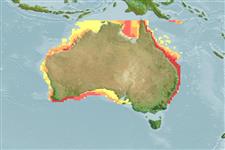Elasmobranchi (squali e razze) (sharks and rays) >
Orectolobiformes (Carpet sharks) >
Brachaeluridae (Blind sharks)
Etymology: Brachaelurus: brachys (Gr.), short, referring to short and stout body; aelurus, from ailouros (Gr.), cat, i.e., a short catshark. (See ETYFish); waddi: Name given on a painting (now lost) by British ornithologist John Latham (1740-1837), from which it was described; meaning unknown, possibly based on waddi or waddy, an Australian aboriginal name for a war club and a species of tree (Acacia peuce) endemic to central Australia. (See ETYFish).
More on authors: Bloch & Schneider.
Environment: milieu / climate zone / depth range / distribution range
Ecologia
marino associati a barriera corallina; distribuzione batimetrica 0 - 140 m (Ref. 6871). Tropical; 11°S - 36°S, 112°E - 143°E (Ref. 54288)
Southwest Pacific: confined to Australia, southern Queensland and New South Wales. Records from Western Australia and northern Territory need confirmation.
Size / Peso / Age
Maturity: Lm ? range ? - ? cm
Max length : 122 cm TL maschio/sesso non determinato; (Ref. 247); common length : 62.0 cm TL maschio/sesso non determinato; (Ref. 247); common length :66 cm TL (female)
Spine dorsali (totale): 0; Raggi dorsali molli (totale): 0; Spine anali 0; Raggi anali molli: 0. Mostly with white spots on body (Ref. 13576). Caudal fin with its upper lobe at a low angle above body axis, with a strong terminal lobe and subterminal notch but no ventral lobe (Ref. 13576).
Usually found close inshore in tide pools (barely deep enough to keep it covered) and at the surf line, but sometimes deeper (Ref. 247). Prefers rocky shoreline areas and coral reefs (Ref. 247, 43278). Feeds on small reef invertebrates (Ref. 247), including crabs, shrimps, cuttlefish, squid and sea anemones (Ref. 43278), and small fishes (Ref. 247). Ovoviviparous (Ref. 43278, 50449). Thrives in an aquaria and capable of living out of water for a long time (Ref. 247).
Ovoviviparous, embryos feed solely on yolk (Ref. 50449). With 7 or 8 young in a litter (Ref. 247). Distinct pairing with embrace (Ref. 205).
Compagno, L.J.V., 1984. FAO Species Catalogue. Vol. 4. Sharks of the world. An annotated and illustrated catalogue of shark species known to date. Part 1 - Hexanchiformes to Lamniformes. FAO Fish. Synop. 125(4/1):1-249. Rome, FAO. (Ref. 247)
IUCN Red List Status (Ref. 130435)
Human uses
Pesce da pesca sportiva: si
Informazioni ulteriori
BibliografiaAcquacolturaProfilo di acquacolturaVarietàGeneticaElectrophoresesEreditarietàMalattieElaborazioneNutrientsMass conversion
Strumenti
Special reports
Download XML
Fonti Internet
Estimates based on models
Preferred temperature (Ref.
123201): 19.3 - 26.1, mean 24.2 °C (based on 140 cells).
Phylogenetic diversity index (Ref.
82804): PD
50 = 1.0000 [Uniqueness, from 0.5 = low to 2.0 = high].
Bayesian length-weight: a=0.00389 (0.00180 - 0.00842), b=3.12 (2.94 - 3.30), in cm total length, based on all LWR estimates for this body shape (Ref.
93245).
Trophic level (Ref.
69278): 3.9 ±0.62 se; based on food items.
Resilienza (Ref.
120179): Molto basso, tempo minimo di raddoppiamento della popolazione più di 14 anni (Fec=7).
Fishing Vulnerability (Ref.
59153): High to very high vulnerability (73 of 100).
Nutrients (Ref.
124155): Calcium = 11.8 [2.5, 44.6] mg/100g; Iron = 0.368 [0.089, 1.012] mg/100g; Protein = 19.5 [17.3, 21.5] %; Omega3 = 0.0912 [, ] g/100g; Selenium = 38.2 [11.8, 102.1] μg/100g; VitaminA = 42.8 [16.4, 113.8] μg/100g; Zinc = 0.772 [0.380, 1.593] mg/100g (wet weight);
